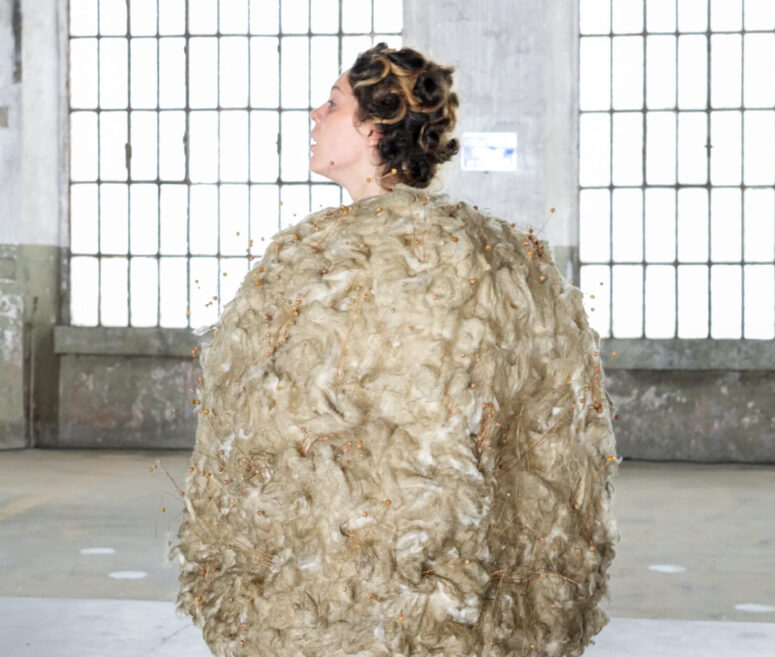An artist, choreographer, and dancer whose practice spans video, sculpture, and performance, Cecilia Bengolea (Buenos Aires, 1979) often exploits dance as a means through which to stimulate empathy and encourage emotional exchange.
In her recent research conducted at the National Linen and Hemp Mill in Villa d’Almè, Bengolea links the era of the Industrial Revolution to the practice of “Free Dances”: devised by both well-known and lesser-known choreographers between the two World Wars, which she often makes use of. The one elaborated by the Argentine artist herself is a reflection on contemporary alienation. The result is a performance specially conceived for Thinking Like a Mountain and for the spaces of the former spinning mill.
Observation of the rotary and mechanical movements of the machinery used in the hemp and linen spinning rooms, as well as the repetitive movements of the manual labor performed by the workers, was the source of inspiration for the choreography of Spin and Break Free. Specifically, the six young male and female dancers from the Danzarea school in Mozzo, Bergamo—Francesca Carobbio, Martina Galluzzi, Alessia Morganti, Francesca Opini, Umberto Rota, Virginia Gotti—were invited by Bengolea to work on a rotary and repetitive movement, that of spinning, which by repeating a single action activates a meditative, generative, and potentially liberating state of mind. The condition induced by the repetitive rotation of the performers’ bodies, in fact, may trigger energies that translate into movements endowed with spontaneity and vitality, capable of interrupting mechanical repetitiveness while leaving room for improvisation.
These movements are complemented by some repertoire drawn from the Free Dances of the 1930s. In particular, the artist worked with the dancers drawing on the teachings of François Malkovsky that it was necessary to rediscover “natural human movement.” The French dancer and choreographer, among the pioneers of the School of Free Dance in Paris, was inspired by the movements of natural elements or children’s gestures in his search for the “right movement,” of which gravity, fluidity of gesture, breathing, momentum, and economy of effort formed the mainstay.
Along with the choreography, Bengolea designed the stage costumes worn by the dancers using hemp stems and linen fibers, the characteristics of which vary depending on the stage at which the fibers are processed. Made in collaboration with costume designer Alberto Allegretti, they are inspired by the Theyyam ritual, which takes place annually in Kerala, India, during harvest season, when the dancers wear clothes made from the fibers of pepper, cardamom and vanilla plants.
Costumes play a key role within the performance: interpreted as living sculptures, the dancers are invited to interact creatively with the costumes, which sometimes affect their movements or restrict certain parts of their bodies such as their eyesight or arms. Much like continuous rotational movement, costumes—in interaction with the dancers—can potentially shape new gestures and movements that are freer and more spontaneous, thus rejecting the alienation induced by repetitiveness.
The costumes come to life along with the dancers in a form of material animism evoked by the words of the mill workers, interviewed by the artist, who state how they often used to “talk” to the linen, attributing a kind of will to it. The workers’ voices are integrated into the soundtrack that accompanies the performance, composed by the artist especially for the occasion.
Spontaneity-mechanicalness, repetition-release, improvisation-constriction, alienation-rebellion: these are all opposites that permeate every element of the performance: starting from the performers’ initial mechanical movements, it evolves into collective choreography and elements of the Free Dancerepertoire, integrated with House Dancerhythms, until it culminates in the finale, when the dancers break free in a playful ronde, evoking the naturalness of childlike gestures.
The performance is held as part of the fourth edition of ON AIR – Argentina–Italy Art Residency, the residency program arising from a partnership between GAMeC and Fundación PROA in Buenos Aires, to activate exchanges of experiences aimed at enhancing the artistic potential of the two countries.





